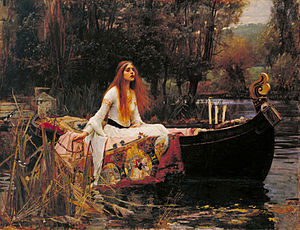The Lady of Shalott (painting)
| The Lady of Shalott | |
|---|---|
 |
|
| Artist | John William Waterhouse |
| Year | 1888 |
| Medium | Oil on canvas |
| Dimensions | 183 cm × 230 cm (72 in × 91 in) |
| Location | Tate Britain, London |
The Lady of Shalott is a painting of 1888 by the English painter John William Waterhouse. It is a representation of the ending of Alfred, Lord Tennyson's 1832 poem of the same name. Waterhouse painted three different versions of this character, in 1888, 1894 and 1915. It is one of his most famous works, which adopted much of the style of the Pre-Raphaelite Brotherhood, though Waterhouse was painting several decades after the Brotherhood split up during his early childhood.
The Lady of Shalott was donated to the public by Sir Henry Tate in 1894, and is usually on display in Tate Britain, London, in room 1840.
The Lady of Shalott is one of John William Waterhouse's most famous works, an 1888 oil-on-canvas painting of a scene from Tennyson's poem in which the poet describes the plight of a young woman, loosely based on the figure of Elaine of Astolat from medieval Arthurian legend, who yearned with an unrequited love for the knight Sir Lancelot, isolated under an undisclosed curse in a tower near King Arthur's Camelot. Waterhouse painted three different versions of this character, in 1888, 1894 and 1915.
The painting has the precisely painted detail and bright colours associated with the Pre-Raphaelites. The Lady of Shalott pictures the Lady, who is the main character in Tennyson's poem, also titled The Lady of Shalott (1842), who is facing her destiny. The Lady has made her way to this small canoe with a few of her belongings. She had been confined to her quarters, not allowed to go outside or even look outdoors. "A curse is on her if she stay", wrote Tennyson. In the poem, a curse had been put on the Lady, but she defies the rules of the curse to see if she could live outside of her confinement. This is the moment that is pictured in Waterhouse's painting, as the Lady is leaving to face her destiny. She is pictured sitting on a tapestry, which showcases Waterhouse’s strong attention to detail.
...
Wikipedia
